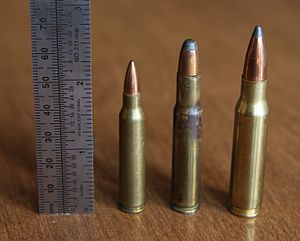.30 Remington
This article needs additional citations for verification. (January 2013) |
| .30 Remington | ||||||||||||||||||||
|---|---|---|---|---|---|---|---|---|---|---|---|---|---|---|---|---|---|---|---|---|
 | ||||||||||||||||||||
| Type | Rifle | |||||||||||||||||||
| Place of origin | United States | |||||||||||||||||||
| Production history | ||||||||||||||||||||
| Designer | Remington Arms | |||||||||||||||||||
| Designed | 1906 | |||||||||||||||||||
| Manufacturer | Remington Arms | |||||||||||||||||||
| Produced | 1906-1980s | |||||||||||||||||||
| Specifications | ||||||||||||||||||||
| Case type | Rimless | |||||||||||||||||||
| Bullet diameter | .308 in (7.8 mm) | |||||||||||||||||||
| Base diameter | .421 in (10.7 mm) | |||||||||||||||||||
| Rim diameter | .422 in (10.7 mm) | |||||||||||||||||||
| Rim thickness | .045 in (1.1 mm) | |||||||||||||||||||
| Case length | 2.06 in (52 mm) | |||||||||||||||||||
| Overall length | 2.525 in (64.1 mm) | |||||||||||||||||||
| Maximum CUP | 38000 CUP | |||||||||||||||||||
| Ballistic performance | ||||||||||||||||||||
| ||||||||||||||||||||
| Test barrel length: 22" Source(s): http://www.chuckhawks.com/30_Rem.htm | ||||||||||||||||||||
The .30 Remington cartridge was created in 1906 by Remington Arms. It was Remington's rimless answer to the popular .30-30 Winchester cartridge. Factory ammunition was produced until the late 1980s, but now it is a prospect for handloaders. Load data for the .30-30 Winchester can be used safely for the .30 Remington.
Background[]
Although the cartridge has dwindled into obscurity it lives on by being the parent case of the 10mm Auto[1][2] the 6.8mm Remington SPC and .224 Valkyrie cartridges. Unlike the .30-30, the .30 Remington can utilize standard pointed bullets rather than round nosed ones when used in rifles with box magazines (Remington Model 8) and ones with special tubular magazines (Remington Model 14). This gives it a possible advantage over the .30-30 cartridge which is most often chambered in lever-action rifles with standard tubular magazines (in which a conventional pointed bullet could lead to cartridges being ignited in the magazine tube by recoiling into a primer).
While the .30 Remington is ballistically equivalent to the .30-30 Winchester cartridge, the cartridges are dimensionally different and are not interchangeable. However, .30 Remington cases can be made from .30-30 cases by turning off the rim, cutting an extractor groove, and fire-forming the shoulder.
See also[]
References[]
- Pistol and rifle cartridges
- Remington Arms cartridges